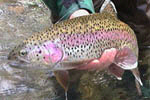I
have spent a lot of time observing the panfish and bass in
the waters of Central Texas. Using top water, nymphs and
streamers I have noticed different patterns the fish
themselves follow. Now I do have to admit, my favorite
action is top water, however I have caught many a good
panfish using nymphs as well as bass on streamers.
During this last summer while
fishing on the Llano, I was using hoppers, specifically the EZ Hoppers created by
Peter Frailey. These hoppers were catching a lot of fish and I would
go through at least five or six a day as the bream and bass would
chew on them pretty good. It was during this time I was noticing
that while the hopper was on the surface moving down with the
current, the bream would hit it repeatedly until the hook was set or
it escaped the bream to reach the end of the drift. As I was
stripping it back, it was totally ignored by all fish until the
currents caught the hopper in a particular fashion and it was pulled
under. It was at this moment in almost each cast that the bass would
take it. Most of the time it was Spotted Bass that took the
hopper.
Now this got the wheels turning
in my head. I departed from my tried and true drift and strip
technique and began to experiment. I would cast downstream and when
stripping the hopper back in I would try to get it to submerge. Just
about each time I could get it submerged, the bass would do a hit
and run, it was great! The rest of the day I used some sink putty
from Orvis to keep the hopper down, but it limited me to using a
surface fly as a sinking terrestrial. The bream pretty much would
not touch it.
|
 |
When I got home that night I
started looking through all the books and web sites for something
that could meet all techniques as well as attract both bream and
bass. After a long intensive search I could not find anything that
would suit my goal. So I looked at several hopper patterns along
with "diver" patterns, considered the various materials available
and after several trials and errors the Diving Hopper One (DH1) was
born. Why the "One", itís the first fly I have created and believe
to be unique. Besides, it sounds good.
The fly reacts well in moving
water. The tail acts as an attractant, the chenille body provides a
tougher body material that can take the repeated strikes of bass,
the legs to simulate that of a terrestrial, the collar provides
buoyancy and a surface plane to dive the hopper. By varying the size
and angle of the collar, the hopper will react in different ways
from slipping quietly below the surface up to becoming a noisy
popper. Be aware that if the collar is not perpendicular to the
hook, it will cause the fly to spin underwater and your tippet will
only last a couple of casts before it becomes a tangled
mess.
Now I can fish the drift and
strip technique, surface and subsurface all on the same fly. This
fly has proven itself to be a deadly combination the rivers, Llano,
San Gabriel, Colorado and several local creeks including Brushy.
Both panfish and bass love this fly. Yellow works best here but any
combination can be applied for the various fisheries throughout the
world.



